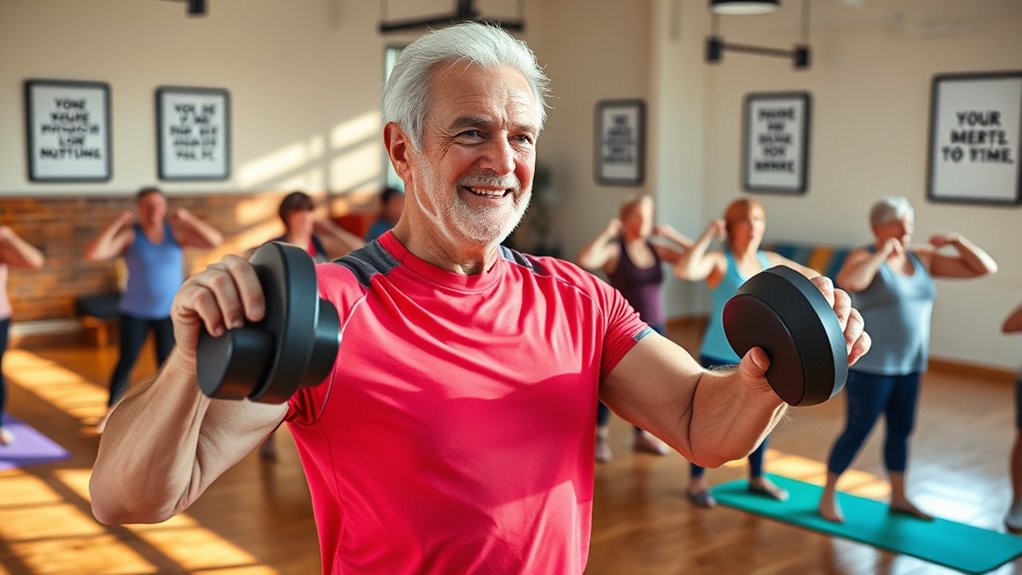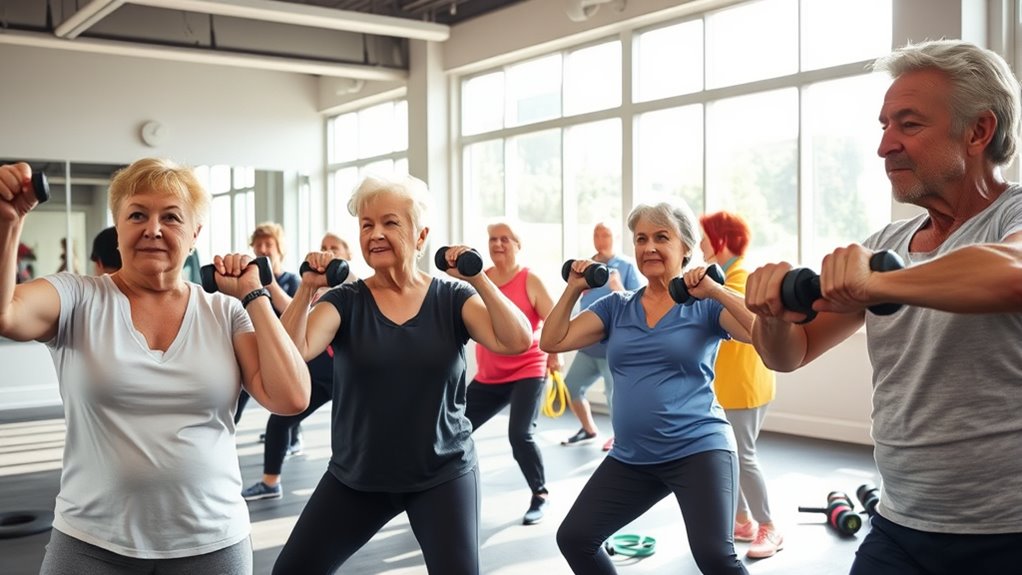Lifting weights can boost your energy as a senior by combating the effects of aging, like muscle loss and reduced flexibility. Start with light weights or resistance bands and focus on proper form to avoid injuries. To support recovery, clean nutrition is key, with protein-rich snacks post-workout. Remember, consistency and setting achievable goals are essential for progress. If you stick with it, you’ll find plenty of tips and exercises to enhance your strength and wellbeing.
Key Takeaways
- Begin with low-impact weight exercises, like gentle dumbbell lifts, to build strength safely and effectively.
- Use resistance bands or light weights (1-10 lbs) to enhance muscle strength and improve balance.
- Incorporate bodyweight exercises, such as squats and wall push-ups, to target major muscle groups.
- Maintain a balanced diet rich in protein and nutrients to support muscle recovery post-workout.
- Join group classes or community programs for motivation, accountability, and social support in your fitness journey.
Understanding the Aging Process

As you age, your body undergoes several changes that can impact your overall health and well-being. One significant change is sarcopenia, the gradual loss of muscle mass and strength, which increases your risk of falls and decreases your independence. Emotional instability can also affect motivation and consistency in maintaining a workout routine, making it crucial to establish a supportive environment. Individuals with certain mental health conditions, such as Borderline Personality Disorder, may particularly struggle with maintaining a stable fitness routine due to emotional fluctuations. Engaging in effective relaxation techniques can also help reduce stress and enhance your focus on fitness goals. Additionally, implementing risk management strategies can be beneficial in creating a balanced approach to your fitness and health investments.
Alongside this, your bone density often declines, making you more susceptible to fractures. This is where incorporating light weights into your routine becomes essential; strength training not only helps combat muscle loss but also improves bone health.
Additionally, aging can reduce flexibility and balance, hindering your mobility. Resistance exercises with light weights can enhance these aspects, while also boosting your cardiovascular health. Moreover, understanding financial considerations for elderly care is vital to ensure you have the resources necessary for maintaining an active lifestyle as you age.
Getting Started With Strength Training

Getting started with strength training can feel challenging, but it’s an essential step toward maintaining your health and independence as you age.
Before diving in, consult with your healthcare provider to guarantee safety and address any health concerns. One step you can take is to develop a personalized exercise routine with a certified trainer, focusing on your unique strengths and limitations. Strong communication skills between you and your trainer will enhance clarity and ensure you are following the right regimen. Regular physical activity can significantly improve men’s health, making it crucial to incorporate it into your routine. Additionally, engaging in activities that promote overall ambiance and mental well-being can further enhance your fitness journey. Necessary cookies are crucial for maintaining basic site functionalities, just as foundational exercises are essential for your strength training.
Begin with low-impact activities like chair yoga or gentle dumbbell lifts to build strength and balance gradually. Incorporating bodyweight movements and resistance bands at home can also be effective. Additionally, ensure you are consuming nutritional support that includes essential nutrients like protein to help promote muscle growth.
Remember to progress slowly in intensity and pay attention to your nutrition to support muscle growth and overall well-being. With these foundational steps, you’ll set yourself up for success.
Strength Training Exercises for Seniors

Strength training exercises for seniors offer a practical way to boost muscle mass and enhance overall strength, making daily activities easier and more enjoyable. You can start with bodyweight squats and wall push-ups, which accommodate individual fitness levels. Using resistance bands or light weights (1-10 lbs) can further improve muscle strength and balance without needing specialized equipment. Incorporating regular physical activity into your routine is essential for overall health and vitality. Engaging in strength training can also help you manage RMDs, ensuring you maintain financial wellness in retirement. Additionally, studies show that regular resistance training can lead to significant improvements in overall wellness and longevity for seniors. Regular outings to dog parks can also enhance social interaction and physical activity, which are important for maintaining vitality.
Regular resistance training helps combat sarcopenia, promoting your independence and quality of life. Remember, maintaining proper form is essential; focus on quality of movement to minimize injury risks. Incorporate exercises that target major muscle groups, such as lunges, bicep curls, and core workouts, to enhance flexibility and well-being. To support your training, ensure you maintain proper hydration, as water requirements play a crucial role in overall physical performance.
Enjoy the journey to a stronger, healthier you!
Safety Tips and Injury Prevention

When engaging in strength training, prioritizing safety is imperative to prevent injuries and guarantee a positive experience. Start by confirming proper exercise techniques to minimize the risk of injury. Additionally, incorporating essential oils into your post-workout routine can aid in muscle recovery, as certain oils like lavender can promote relaxation and reduce soreness. Using cold medications effectively can also help alleviate any discomfort from training-related colds, ensuring you stay on track with your workouts. It’s also beneficial to consider dilution guidelines for essential oils to ensure safe application during your recovery routine.
Incorporate warm-up and cool-down periods into your routine, as these are essential for preparing your muscles. Focus on quality of movement rather than quantity; maintaining proper form is critical for avoiding strain.
Gradually progress in intensity and resistance to confirm continuous improvement without overexerting yourself. Finally, listen to your body and be attentive to any signals of discomfort or fatigue. Additionally, understanding the importance of advance directives can ensure your healthcare wishes are respected, allowing you to focus on your fitness goals without worry.
These safety tips will help you stay injury-free and make your strength training enjoyable and effective, allowing you to lift your way to vitality.
Nutrition and Recovery

As you immerse yourself in strength training, remember that proper nutrition plays an essential role in your recovery and overall performance.
A balanced diet rich in protein, vitamins, and minerals supports muscle repair and strength gains crucial for your workouts. After exercising, snack on protein-rich foods like Greek yogurt or nuts to aid muscle health and promote synthesis. Incorporating chia seeds into your post-workout snacks can provide additional omega-3 fatty acids that support muscle recovery. The soluble fiber in chia seeds also aids digestion, helping your body absorb nutrients more efficiently. However, be mindful of potential allergic reactions to chia seeds, as individual sensitivities can vary.
Hydration is equally important—make sure to drink water throughout the day, especially before and after your sessions.
Don’t underestimate quality sleep; it’s critical for recovery, allowing your body to repair muscles and replenish energy stores. Additionally, herbal teas like ginger tea may help reduce inflammation and support recovery after intense workouts.
For personalized advice that aligns with your fitness goals, consider consulting a registered dietitian to enhance your nutrition strategy.
Overcoming Common Challenges

Overcoming common challenges in strength training is important for seniors to achieve their fitness goals. Many older adults face limited mobility or past injuries, but consulting with healthcare providers can help create a safe, tailored program.
Fear of injury is another barrier, yet working with certified trainers can teach you safe techniques and modifications to build confidence. Staying motivated can be tough too; setting realistic, achievable goals with a personal trainer can keep you engaged.
If you’re unsure about effective exercises, start with simple bodyweight movements or resistance bands to strengthen your muscles at home.
Don’t forget, a balanced diet rich in protein and hydration is essential for recovery and muscle growth, supporting your overall well-being in this journey.
Measuring Progress and Adjusting the Routine

To effectively track your progress in strength training, regularly evaluating your performance is key. Start by measuring progress through the number of repetitions, sets, and weights you lift.
Keep a fitness journal or use an app to record workouts and note any changes in how you feel after each session. This helps you recognize patterns and areas that need adjustment.
Recording your workouts in a journal or app allows you to track progress and identify areas for improvement.
Every 4-6 weeks, consider modifying your routine to include new exercises, increase weights, or change repetitions to prevent plateauing. Incorporate periodic fitness assessments to evaluate balance, flexibility, and overall strength.
If you’re unsure about adjustments, consulting with a certified personal trainer or healthcare provider can guarantee your routine remains safe and aligned with your evolving fitness goals.
Building a Supportive Community

Building a supportive community around strength training not only boosts your motivation but also makes exercising more enjoyable.
Joining group exercise classes or local fitness clubs connects you with others who share similar goals, fostering a sense of belonging and accountability. This socialization can improve your mental health and overall well-being.
By participating in community fitness programs, you’ll experience encouragement and shared successes, making strength training feel less isolating. Engaging with peers in a supportive environment helps you overcome barriers like fear of injury or uncertainty about proper techniques.
Plus, establishing a network allows you to share tips, success stories, and nutritional advice, empowering you to achieve your fitness goals more effectively.
Frequently Asked Questions
What Is the Number 1 Exercise to Increase Balance in Seniors?
The number one exercise to increase balance in seniors is the single-leg stand. It enhances stability and engages your core muscles, which are essential for maintaining balance.
Research shows practicing this exercise can reduce the risk of falls by up to 30%. You can do it anywhere, requiring no equipment.
Start by holding onto a sturdy surface for support and gradually increase the duration to build strength and confidence in your balance.
What Is the Best Weight Lifting Routine for Seniors?
To create the best weight lifting routine for seniors, focus on low-impact exercises with light weights.
Start with 1-3 lbs if you’re a beginner and gradually increase to 10 lbs as you progress.
Incorporate exercises like lunges, squats, bicep curls, and shoulder presses, targeting different muscle groups.
Prioritize proper form to prevent injuries, and aim for 2-3 sessions a week to enhance strength, flexibility, and overall well-being.
How Many Times a Week Should a 70 Year Old Lift Weights?
Did you know that strength training can reduce the risk of falls by nearly 30% in seniors?
For a 70-year-old, lifting weights at least two days a week is ideal for maintaining muscle mass and overall health. Each session should focus on major muscle groups, lasting 30 to 60 minutes.
Remember to allow 48 hours of recovery for the same muscles to promote growth and avoid injury. Always consult with a healthcare provider for personalized advice.
What Is the Best Exercise for Vitality?
When it comes to boosting your vitality, strength training‘s hard to beat. It enhances muscle mass, improves balance, and supports bone density, all essential as you age.
Incorporating resistance exercises into your routine doesn’t just help you feel stronger; it makes daily tasks easier and keeps you independent.
Plus, it benefits your heart health. So, grab those weights and get moving—your body will thank you!
Conclusion
So, as you commence on this journey to lift your way to vigor, remember, even Hercules had to start somewhere. Embrace the strength training exercises tailored for you, prioritize safety, and fuel your body with the right nutrition. Don’t shy away from challenges; they’re just stepping stones to your goals. With determination and support from your community, you’ll not only measure progress but also redefine what it means to thrive as you age. Keep lifting, and enjoy the journey!










